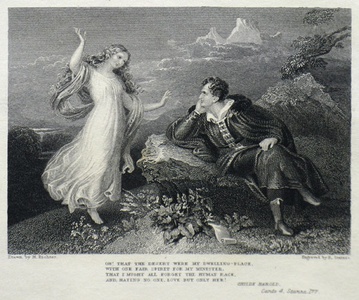| Method | Steel engraving |
| Artist | Robert Staines after Henry James Richter |
| Published | London: Virtue & Co. Limited. c.1840 |
| Dimensions | Image 76 x 101 mm, Sheet 160 x 248 mm |
| Notes |
Inscription below the image in the form of four lines of verse: 'Oh! That the desert were my dwelling-place, With one fair spirit for my minister, That I might all forget the human race, And, hating no one, love but only her.' Childe Harold, Canto 4, Stanza 177. Prints of scenes from Byron's life and poems were extremely popular in both Britain and the Continent, and Byron's death, so appropriately dramatic and in keeping with one of his very own Byronic heroes, only increased demand. Richter's in one of a group of names mentioned in an advertisement from October 1832 for a series of prints available from the publisher Smith, Elder, & Co. of Cornhill. The prints, entitled The Byron Gallery, were described and sold as a series of 'historical embellishments to illustrate the poetical works of Byron'. The publication also included directions for interleaving the prints in any edition of Byron's works, from publishers in England, France, Germany, and America. This print is evidently a later printing from the edition of Byron's poems published by Virtue & Co, as the original publication line for Smith, Elder, & Co. has been replaced. This scene is the perfect rendering of the Romantic hero. Byron sits atop a rocky outcrop, with his muse alone in all the world for company, an empty parchment at the poet's feet. The desert invoked in the lines below is one of Romantic Nature, where one can be alone with one's thoughts, rather than true desolation. In this image, it is a rugged landscape evocative of the Swiss Alps, or perhaps the Alban Hills Byron evokes in an earlier stanza. The escape from humanity back to the chaotic and emotional states of Nature was a central part of the Romantic movement, encapsulated perfectly by the following Stanza of Canto 4: There is a pleasure in the pathless woods, There is a rapture on the lonely shore, There is society, where none intrudes, By the deep Sea, and music in its roar: I love not Man the less, but Nature more. Henry James Richter (1772 - 1857) was a British printmaker, painter, poet, and philosopher. Richter was one of a circle of painters and printmakers heavily involved in the revival of the works of Milton and Shakespeare during the 1790s. In his youth he was apprenticed to Thomas Stothard, whose paintings of scenes from Milton's Paradise Lost were engraved by Bartolozzi, and through Stothard began an association with William Blake. Richter was also a prolific painter of scenes from the works of Lord Byron, and engravings after his pictures accompany many of Byron's works, including The Bride of Abydos, Don Juan, Mazeppa, Heaven and Earth, The Corsair, and Childe Harold's Pilgrimage. |
| Framing | mounted |
| Price | £50.00 |
| Stock ID | 26453 |

